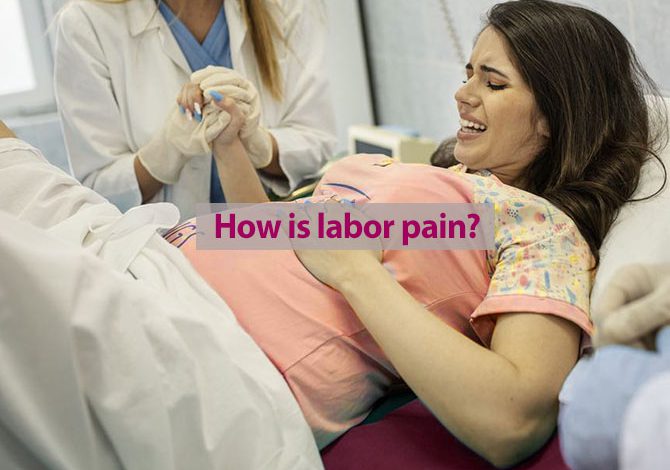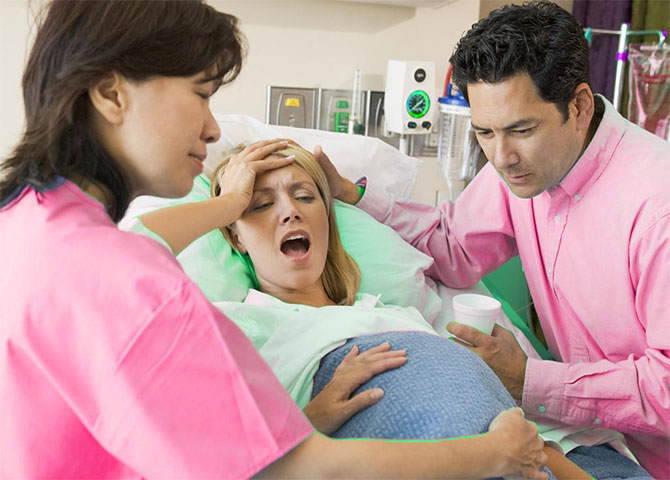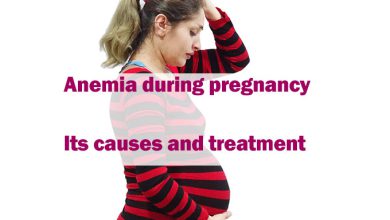How is labor pain?

In the past, the pain of childbirth has been described as one of the most painful moments. The intense pressure of pregnancy cannot be denied, but with various solutions and increasing the mother’s awareness, it can lead to a reduction in pain during childbirth. In this case, you experience a pleasant situation.
The muscle contractions of the uterus and the pressure on its wall cause labor pain. In fact, the pressure of the baby on the bladder, intestines, and stretching of the birth canal, and vagina are the main causes of pain during birth, and it can be said that the process of giving birth to the baby begins in this state.
You must have heard in movies or pregnant women around you that natural birth is a difficult experience with severe pain tolerance. But what is the pain of childbirth really like and how much pressure does a pregnant woman experience? Stay with us and let us introduce you to the ways, types, and methods of reducing labor pains in this article.
Related posts: Headache during pregnancy
How is labor pain?
Every woman experiences her own unique birth. In fact, it can be said that the feeling of pain is a mental category that appears completely different in everyone. Therefore, it is not possible to compare the form and intensity of labor pain of a woman with her mother or sister.
The most important thing to pay attention to is that the pains caused by pregnancy can be controlled with medicinal measures and basic solutions.
Researchers have tried to measure the intensity of pain in different stages of labor, but after various studies, they concluded that labor pressure is not just a physical feeling. Rather, it can be considered largely influenced by mental factors such as fears, personal memories, behavior, and your experience of pain.
What does labor pain really feel like?
Pain during pregnancy will be accompanied by a break between contractions and intense pressures. Therefore, it can be said that this pain during childbirth is not always constant. If the expectant mother thinks that this pain is purposeful, intermittent, predictable, and considered part of the natural process of giving birth to her child, she can tolerate it more.
Influential factors of pregnancy pain
Labor pains will be different for every woman. In fact, this pain can be completely different from one pregnant woman to another and in different pregnancies. The intensity of pain in different stages of labor depends on several factors, including:
- The ability to contract
- The size and position of the baby in the pelvis (ideal position of the baby)
- Whether the drug Pitocin (a synthetic version of the hormone oxytocin that causes the contraction of the uterus and the beginning of the birth process) was used for delivery or not.
- Mother’s pain threshold
- The speed of the mother’s delivery
Your genetics and personal experiences can determine your ability and threshold for labor pains. Factors such as emotional support, fear, anxiety, or hearing negative and positive experiences about childbirth affect your understanding of this process.
Labor pain symptoms
Most pregnant women have described the symptoms of labor pain in the form of cramping in the abdomen and groin with a feeling of relatively intense pressure. Most of these women feel long-distance pains in their flanks and thighs, and the interval between them decreases over time.
Some women have reported that the symptoms of labor pain are similar to severe menstrual cramps, but others consider this pain to be a strong pressure or strong waves like diarrhea cramps.

In general, it can be said that the symptoms of labor pains, in addition to abdominal and pelvic contractions, include a feeling of pressure in the back, the distance between the vagina and the anus (increases during natural childbirth), intestines, and bladder.
Types of natural childbirth pain
The intensity of pain in different stages of labor appears differently for each person. But in general, the types of labor pain and its stages can be categorized as follows:
1. Primary pain
If you are experiencing labor for the first time, your initial push will be around 6 hours or more. The cervix is thinned and opens about 3 to 4 cm. The initial labor pain is accompanied by mild contractions that last about 30 to 60 seconds and the pregnant woman feels them every 5 to 20 minutes. Over time, this process will become more and more intense.
2. Active labor pain
This pain lasts about 2 to 8 hours. The cervix opens up to 7 cm and the expectant mother feels stronger contractions for longer and less often. You can ask the nurse for painkillers in the active pain phase.
3. Transfer pain
The pains of this stage of pregnancy last for 1 hour and are very intense, as the cervix opens up to 10 cm. During transition labor, you feel very strong contractions very close together.
4. Pressure pain
The pain caused by pressing, which is very severe, will last from a few minutes to 3 hours. You tend to push the baby out with strong pressure. Most pregnant women say that intense pressure reduces pain. After seeing the baby’s head, you may feel a burning sensation around it due to the stretching of the vaginal opening.
5. Placental delivery pain
This pain lasts for a maximum of 30 minutes and will be an easy stage for the mother. With mild contractions of the uterus, the placenta will be removed easily, and in case of any problems, the special care team in the operating room will help you. Most mothers are holding their babies at this stage and do not notice the pain caused by the process of removing the placenta.
Method of reducing labor pain
Many pregnant women feel stressed and worried when it comes to natural childbirth, and this makes them nervous. You can use basic and effective solutions before and during childbirth to reduce the pain of childbirth.
Before giving birth
- Following a regular exercise program (pregnancy yoga) will control your blood pressure, and weight and maintain your mood. It can also help fit the body shape of the expectant mother for delivery.
- Participating in childbirth preparation classes will help you relax and feel better during childbirth. In these classes, you and your wife will be taught the necessary measures for a comfortable natural birth.
- Consuming healthy foods and pregnancy vitamins will help your baby develop fully and provide you with the energy you need for delivery.
- Another way to reduce this pain is to pay attention to the baby’s position. If the baby is not placed transversely or breech, the mother will experience less painful labor
During childbirth
- During labor, it is better to focus on stronger contractions with the help of breathing techniques to manage labor pains.
- Water delivery is considered a way to reduce labor pain. But if it is not your choice, you can manage it better by showering.
- A 15-minute massage such as a hand, back, leg, or shoulder massage will provide better pain management.
- Listening to music mentally prepares you for a natural birth. Researchers suggest listening to your favorite music at the beginning of labor pain to control your stress and blood pressure.
- Slow walking, rolling on the ball of labor, and slow dancing help to reduce.
- Some women experience nausea when the initial pain starts and progresses, so it is better to use aromatherapy (mint, lavender, citrus oils).
- If necessary, you can ask your obstetrician and gynecologist to inject some epidural painkillers intravenously to reduce the pain for a while.
What are the types of labor pains?
What are the methods of pain relief in labor?
What is the most common type of pain relief for labor?
What methods of reducing pain are taught in childbirth classes?
final word
No woman can say for sure what labor pain is like. Because this process will be different in multiple births of a woman. But you should not be afraid of natural childbirth and get stressed because it is different for every pregnant woman. In this article from Dermankade magazine, we introduced you to the methods, types, and methods of reducing labor pain. Have you ever had a natural birth experience? Share your thoughts and experiences with us.
